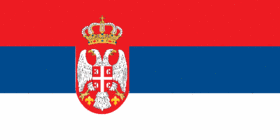Yugoslavia, FRY (Federal Republic of Yugoslavia)

- Det serbiske flag (Photo: CIA Worldfact)
Background
1986: Slobodan Milosevic became President of Yugoslavia.1991: Milosevic’s aspiration for a 'Greater Serbia' led to the declarations of independence of Slovenia and Croatia.
1999: Civil war spread to Croatia, Bosnia, and, finally to Kosovo, where NATO intervened in 1999.
2000: After a revolution in October 2000, Vojislav Kostunica became Yugoslavia's new President.
2003: His Presidency ended in February 2003 when the name Yugoslavia, which means “South Slavs”, was dropped and Yugoslavia was dissolved into its constituent parts of Serbia and Montenegro.
Serbia and Montenegro
Serbia and Montenegro cover 102,172 km2 and have 11.2 million inhabitants.After formation, the new Parliament elected Montenegro’s Svetozar Marovic as the first President of the new union. He expressed his wish that Serbia-Montenegro would join the EU. In March 2003, the Serbian Prime Minister, Zoran Djindjic, was assassinated.
Serbia and Montenegro have a trade agreement with the EU and are also supported under the CARDS programme. Like Albania and Bosnia-Herzegovia, they have only started the Stabilisation and Association Process (SAP) with the EU. Whereas, FYROM and Croatia have already signed a Stabilisation and Association Agreements (SAA).
Links
http://travel.state.gov/yugoslavia.html